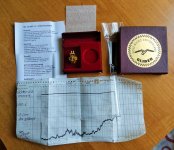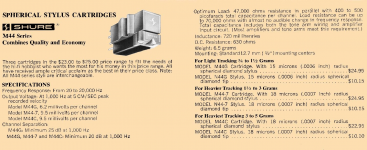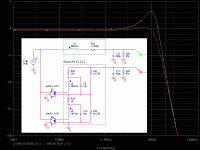What are the Cliff’s Notes for this phono stage? The technical discussion is quite dizzying in this thread.
Is it intended as a stand-alone phono amp for turntable-to-line-level use? Or is it for using between a turntable and other phono RIAA amps?
What cartridge specifications are appropriate, or does the stage need to be tweaked per cartridge?
Is it intended as a stand-alone phono amp for turntable-to-line-level use? Or is it for using between a turntable and other phono RIAA amps?
What cartridge specifications are appropriate, or does the stage need to be tweaked per cartridge?
There are several alternatives being discussed in this thread, but as far as I understand, the original circuit from Nick is meant to convert a moving-magnet cartridge signal into a line level signal, requires one resistor to be tweaked depending on the cartridge characteristics (I may have misunderstood this) and needs to be built into the turntable. Its intended advantages are unusually low noise and the elimination of the electrical resonance of the cartridge with the cable, although the people on this thread have difficulty getting to agree about that last thing.
That's just what I understand of it, Nick knows it better than I do as it is his circuit.
That's just what I understand of it, Nick knows it better than I do as it is his circuit.
Last edited:
[skip]as far as I understand, the original circuit from Nick is
Marcel thanks, you understand my circuit idea, which transforms MM cart sound to the MC level of transparency, but with much better SNR, flat HF response without adjustment and muchmuch lower price.intended advantages are unusually low noise and the elimination of the electrical resonance of the cartridge with the cable, although the people on this thread have difficulty getting to agree about that last thing.
That's just what I understand of it, Nick knows it better than I do as it is his circuit.
And I must also add to your research some measurements of MC cart Benz Micro Glider L2 (0.4 mV, 12 ohms, 75 uH, - see here https://www.patreon.com/posts/anonsiruiu-su-v-70963138 ), confirm the assumption that there are no any meaningful mechanical resonances for more or less modern cartridges with a boron cantilever.
Attachments
Last edited:
Is it intended as a stand-alone phono amp for turntable-to-line-level use? Or is it for using between a turntable and other phono RIAA amps?
stand-alone
my circuit is optimized for any MM cart with inductance from 200 to 1500 mH and no additional adjustment/tweaking required - see here https://www.patreon.com/posts/kritichnost-lcr-68630348What cartridge specifications are appropriate, or does the stage need to be tweaked per cartridge?
How do you know if you can extrapolate that to moving magnet cartridges, particularly the high-inductance ones with a large recommended load capacitance?And I must also add to your research some measurements of MC cart Benz Micro Glider L2 (0.4 mV, 12 ohms, 75 uH, - see here https://www.patreon.com/posts/anonsiruiu-su-v-70963138 ), confirm the assumption that there are no any meaningful mechanical resonances for more or less modern cartridges with a boron cantilever.
You can determine if there is any significant mechanical resonance in the MM cartridge by comparing the frequency responses of the test LP CBS STR120 ( 10 Hz to 50 kHz sweep - IEC60098/2020 table D.1 recommendation ) playback with a successive decrease of input capacitance from C=500 pF to 15 pF and comparing the resulting frequency responses series with the calculated ones for the electrical LCR input equivalent. With mine Shure M44MB, M97HE I see nothing suggestion of measurable effect of nonelectrical resonance. In reality modern boron cantilevered MM cart has almost the same tip mass as MC (in contrast to the fairy tale suggested to us by marketers) and even less recommended tracking force (MM typical 1.5-2 g, MC 2-3 g).How do you know if you can extrapolate that to moving magnet cartridges, particularly the high-inductance ones with a large recommended load capacitance?
Last edited:
Do you want to say something useful about your [un]knowledge on this thread? - Welcome.He knows everything!
I can't Sir...you have all the answers.
Just one more thing....now that you also have a cbs str 120 in good shape would you, please, show us a photo or even better be kind to show us a movie with your disc played back and an oscilloscope measuring it ? I'm really curious to see the waveform between 10hz and 50khz live! I bet everyone on diyaudio would love to see such a measurement live on an oscilloscope!
Just one more thing....now that you also have a cbs str 120 in good shape would you, please, show us a photo or even better be kind to show us a movie with your disc played back and an oscilloscope measuring it ? I'm really curious to see the waveform between 10hz and 50khz live! I bet everyone on diyaudio would love to see such a measurement live on an oscilloscope!
Last edited:
PS. I add something from Shure : "optimum load 47 k resistance can be up to 70 k with almost no audible change in frequency response" - see the attached Shure doc. I up to 150 k (and even more) also without any HF peaking, comprehend? {The one thing is important - lowering preamp and cable Cin to at least 25 pF (LSK389) or 12 pF (jfe2140) }How do you know if you can extrapolate that to moving magnet cartridges, particularly the high-inductance ones with a large recommended load capacitance?
Attachments
Last edited:
OK, I will make such a video especially for you, as I made earlier for others ( see my playlist with hundreds videos at youtube https://www.youtube.com/playlist?list=PLu1Wtw8bW_xjWNlh8FoJh7mfw3hRWOYYY ), but I live in Kiev and we had 12 air alarms yesterday. There is war here now, don`t you know? So please wait a little, OK?Just one more thing....now that you also have a cbs str 120 in good shape would you, please, show us a photo or even better be kind to show us a movie with your disc played back and an oscilloscope measuring it ? I'm really curious to see the waveform between 10hz and 50khz live! I bet everyone on diyaudio would love to see such a measurement live on an oscilloscope!
Last edited:
OKThen leave that place! You'll find support in the west for sure.
If the damping comes mainly from iron losses, the termination resistance gets less critical.PS. I add something from Shure : "optimum load 47 k resistance can be up to 70 k with almost no audible change in frequency response" - see the attached Shure doc. I up to 150 k (and even more) also without any HF peaking, comprehend? {The one thing is important - lowering preamp and cable Cin to at least 25 pF (LSK389) or 12 pF (jfe2140) }
It's a pity they don't mention how many dB it drops off at 20 kHz with the recommended load. 720 mH and 450 pF gives a natural frequency of 8842 Hz, so either the response with the recommended load must be really bad or there must be some other effect counteracting it.
If the response with the recommended load were really bad, why on Earth would they recommend that load?
" If it ain't broke, don't fix it!"
https://www.lencoheaven.net/forum/index.php?topic=2253.105
http://www.hifi-classic.net/review/shure-m97he-307.html
https://www.lencoheaven.net/forum/index.php?topic=2253.105
http://www.hifi-classic.net/review/shure-m97he-307.html
What they wrote is what I wrote too, citation: M44 with "Recommended Load: 47 kΩ; 450 pf" has obvious and rather sharp rolloff above 12kHz (approx as Marcel predict 9 kHz @#175 msg) without any visible mechanical resonance, M97HE "a 475-pF load resulted in excessive loss of output above 10,000 Hz". I measured almost the same in 80s, and found my own correction method without input LCR resonace (with as lowest as possible input capacitance)." If it ain't broke, don't fix it!"
https://www.lencoheaven.net/forum/index.php?topic=2253.105
http://www.hifi-classic.net/review/shure-m97he-307.html
Last edited:
Yes, it is (but iron losses adds thermal noise and is also noxious).If the damping comes mainly from iron losses, the termination resistance gets less critical.
But in those early years I came to the conclusion that mechanical resonance was significant in the era of cartridges with a conical stylus and point contact, but any of the modern cartridges no longer have a point contact, but a larger area ("line") and therefore no longer create mechanical resonance even with relatively heavy cantilever+stylus. Today most of stylus is not spherical/conical but
fine-line (London Decca)
Gyger S (Goldring, Clearaudio)
Vital shank (Goldring, Rega)
Shibata (Ortofon, AT)
Superfine line contact (Nagaoka)
super fineline Gyger II (Roksan)
Special Line Contact (AT)
Micro Ridge (Benz Micro, Sumiko)
VDH - IS (Van den Hul)
isn`t it?
And in my opinion, confirmed by a lot of listening and measurements, neither mechanical resonance nor electrical resonance of the input circuit can be used - they only worsen the frequency response and phase response, as well as noise characteristics.
Last edited:
Perfect response? 😵 Your FR have a giant rolloff at 20kHz.500mH and 1350 ohms series resistance damped by 5..600pf and 47 kohms was the value I used in all my phono simulations and the antiriaa network used in lme49710 datasheet gave perfect response with the traditional 10 khz peaking ... so I don't really know what all the fuss is about
Simulation in absolutely ideal conditions for a Shure V15 III with a load of 47 kΩ || 450 pF gives a roll-off of 8 - 9 dB @ 20 kHz for both the primitive model and the complex one.
Attachments
Last edited:
You can also just calculate that from measured impedance values, see post #159, https://www.diyaudio.com/community/...ono-stage-85-dba-sn-ratio.387375/post-7105107 That eliminates the inaccuracies associated with the step from the measured impedance to the lumped model.
- Home
- Vendor's Bazaar
- Nick Sukhov SU-XXI MM Phono stage -85 dBA SN ratio...


